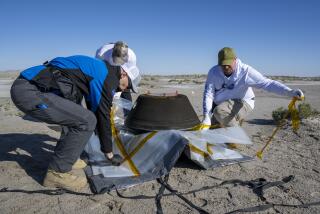SCIENCE / GEOPHYSICS : Second Meteorite Blamed in Extinction of Dinosaurs
- Share via
In a dramatic and controversial new scenario for dinosaur extinction, researchers reported today that the prehistoric creatures may have been done in by a catastrophic shower of meteorites from an asteroid that smashed into the Pacific Ocean 65 million years ago.
Geophysicist Eric Robin and his colleagues at the Center for Low Radioactivity in France assert in the current issue of Nature that asteroid fragments they found in ocean sediments off Japan could not have come from a Mexican meteorite most often blamed for killing off the dinosaurs.
The material under study--finer than sand but chockablock with spinel and iridium, minerals characteristic of meteorites--are undoubtedly extraterrestrial in origin, the French scientists contend in their article. “But their location is difficult to reconcile with an impact on the Yucatan peninsula, some (6,200 miles) away.”
In a telephone interview from his laboratory in Gif-sur-Yvette, France, Robin said that the confirmation of a meteorite that fell into the ocean could give researchers a more complete picture of the climate processes believed by many scientists to have exterminated the dinosaurs.
The heat and pressure created by a large meteorite landing in the ocean would inject a vast amount of water vapor into the atmosphere, he said. In an ancient greenhouse effect, water vapor may have combined with airborne dirt and dust from other meteorite impacts to block enough sunlight to kill off the plants that fed dinosaurs and their prey.
Based on the density of the material they found and other calculations, Robin and his team concluded that the area was struck by a 1 1/4-mile-wide meteorite. From this find, along with evidence of the Yucatan crater and other possible meteor impacts, Robin concludes that the extinction was the work of not one but several extraterrestrial bodies.
“Alone, (the Pacific asteroid) could not have had this catastrophic effect,” he said, “but it’s evidence of multiple impacts globally, and together (a shower of such extraterrestrial objects) could have triggered a mass extinction.”
Robin’s scenario has been challenged by Virgil (Buck) Sharpton, a geophysicist at the Lunar and Planetary Institute in Houston. Sharpton said that the distinctive rock fragments on which Robin based his hypothesis more likely are debris from the collision of one enormous meteorite on the Yucatan Peninsula in Mexico.
“I don’t see that (Robin’s hypothesis) as particularly plausible,” Sharpton said. “But I hesitate to rule it out entirely. I just think there’s a much simpler explanation.”
Sharpton said the crash of a 6.2-mile-wide asteroid in Mexico would have created a huge cloud of vaporized rock and debris. The cloud would have had enough energy to drift around the globe, slowly raining down particles as they condensed from the vapor.
Although Sharpton discounted any evidence that more than one asteroid impact contributed to the death of the dinosaurs, others in the past have suggested just such a scenario. A few have even nominated impact sites on land, but none has yet won wide support among researchers. U.S. Geological Survey scientists are drafting scientific papers disputing the age of the most well-known alternative crater, the Manson site in Iowa.
Even the Yucatan site has been labeled inconclusive by scientists who contend that dinosaurs were extinguished by a more natural phenomenon, such as a burst of volcanic activity or gradual climate change, and not an extraterrestrial event.
Robin said his team has produced new evidence supporting the meteorite theory and expanding it to include several meteorites, among them at least one big one in the ocean.
Evidence suggesting this possible second meteorite was found by scientists drilling into the sea floor to learn more about the geology underlying the oceans. Robin and his colleagues studied a core sample from the northern Pacific, about 1,000 miles east of Japan, then compared it to similar cores taken off North America and in the South Pacific.
All three samples contained fine grains of what appeared to be meteorite remnants. Each had relatively high concentrations of iridium, a silvery metallic element common in space but rare on Earth. Some grains were glassy, as if from rocks that had been heated to the melting point; meteorites reach such temperatures because of friction when they enter Earth’s atmosphere.
The French scientists also assert that the material they studied contains more aluminum and iron than is found in suspected asteroid remnants from the Yucatan Peninsula.





